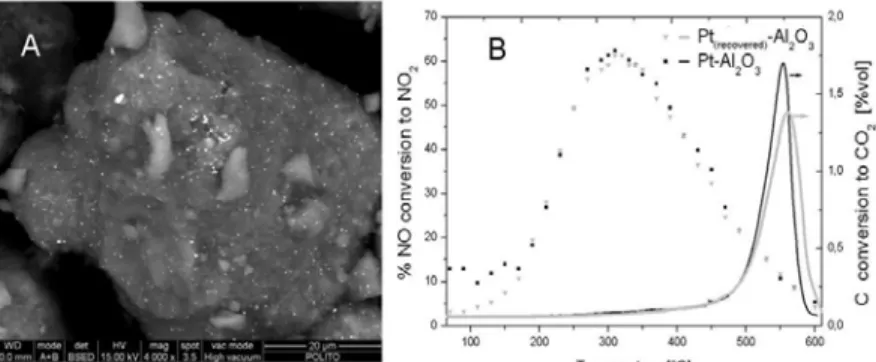NO and C oxidation with Pt recovered from spent catalytic converters
J.C. Caroca, N. Russo, D. Fino*, G. Saracco, V. SpecchiaMaterials Science and Chemical Engineering Department, Politecnico di Torino, C.so Duca degli Abruzzi 24, 10129 Torino, Italy;
*debora.fino@polito.it
Introduction
Automotive catalysts today make almost 50% of the global demand for the Platinum Group Metals (PGM) due to emission limits enforced by international legislation. The catalysts contain either platinum or platinum/palladium combinations for oxidize carbon monoxide (CO) and unburnt hydrocarbons (HC) to carbon dioxide (CO2) and water (H2O).
The recovery of these precious metals present in spent automobile catalytic converters [1] has been an important topic not only for the economic aspect but also for recycling rare natural resources. However, the PGM content is low (2 g per unit)[2], and the unit are enclosed in steel sheet and widely scattered.
The main purpose of this work is to develop a selective recovery process of platinum from a spent catalytic convert using a strong basic ion exchange resin and then to carry out catalytic activity comparison between catalysts based on recovered platinum from spent catalytic converters (Al2O3 as a support) and commercial Pt/Al2O3 catalysts.
Materials and Methods
For Pt recovering, 250g of a spent catalytic convert was treated with 1 liter of aqua regia (HCl/HNO3 = 3:1) as leaching solution [3]. The obtained solution was then processed by
means of the Column ion-exchange procedure[4] to recover the platinum. During the process, absorption atomic analyses were carried out to measure the platinum concentration in the solution.
Two 2wt% Pt/Al2O3 catalyst powder samples were synthesized via incipient
wetness impregnation IWI [5]. The first sample was prepared by using the recovered platinum, whereas the second one was prepared by using an aqueous solution of hydrogen hexachloroplatinate (IV) provided by Sigma-Aldrich.
The activity of the prepared catalysts towards the carbon oxidation was analyzed by means of Temperature-Programmed Combustion (TPC), carried out in a fixed-bed micro-reactor under standard operating conditions [6] (air flow rate of 50 Nml·min-1, carbon/catalyst 1:9 mass basis, W/F = 0.05 g⋅s⋅cm-3, GHSV of 9,000 h-1
,heating rate of 5 °C/min). The outlet
gas was monitored by a CO/CO2 NDIR analyzer (ABB).
The same catalysts were also tested for the oxidation of NO towards NO2 with the
same apparatus [6] according to the following conditions, gas mixture: 93 ppmv NO; 15 vol.% O2, N2 = balance; flow rate of 350 Nml·min-1 , W/F = 0.02 g⋅s⋅cm-3, GHSV of 40,000 h-1,
heating rate of 5 °C/min). The outlet gas was monitored by both a NO/NO2
chemiluminescence analyzer (Eco Physics) and a N2O NDIR analyzer (ABB).
Results and Discussion
After the leaching with aqua regia, a solution containing an elevated concentration of platinum (640 ppm) and several undesiderable compounds (Al, Fe, Si, among others) was obtained. The column ion-exchange procedure with a strong anionic resin ( Amberlite IRA - 400) was used to separate the platinum complex [PtCl6]2-, recovering 71% of the present
platinum, with a pureness of 91% (9% of Ca).
The SEM analysis carried out with the BSE detector showed a ceramic matrix of Al2O3 with platinum cluster having an average diameter of 1 μm finely dispersed onto the
surface for the 2 wt% Pt(recovered)/Al2O3 (see Fig. 1A). An higher platinum cluster average
diameter was observed for the 2 wt% Pt/Al2O3 commercial sample (not reported).
The catalytic activity tests (Fig. 1B) concerning the carbon combustion showed that the 2wt% Pt(recovered)/Al2O3 exhibited a slightly higher peak combustion temperature
(Tp=561°C) compared with the commercial 2 wt% Pt/Al2O3 (Tp=555°C) but with a lower CO2
formation (not reported). Shifting our attention towards the NO oxidation to NO2, both
catalysts showed a similar performance, reaching the highest conversion (~61%) at 310°C with no production of nitrous oxide.
Figure 1. A) SEM view of 2 wt% Pt( recovered)/Al2O3 with a magnification of 4000X; B)
activity results regarding the C conversion to CO2 and NO conversion to NO2.
References
1. M. Benson, C. R. Bennett, J. E. Harry, M. K. Patel and M. Cross. Conservation and recycling. 1, 7 (2000).
2. K. Shams, F. Goodarzi,s. Journal of Hazardous Materials. 131, 229 (2006). 3. M.A. Barakat, M.H.H. Mahmoud. Hydrometallurgy. 72, 179 (2004). 4. R. Gaita, J. Al-Bazi. Talanta.. 42, 249 (1995).
5. E. Cauda, D. Fino, G. Saracco, V Specchia. Topics in Catalysis. 299 (2004 ). 6. D. Fino, V Specchia. Chem. Eng. Sci. 59, 4825 (2004 ).
